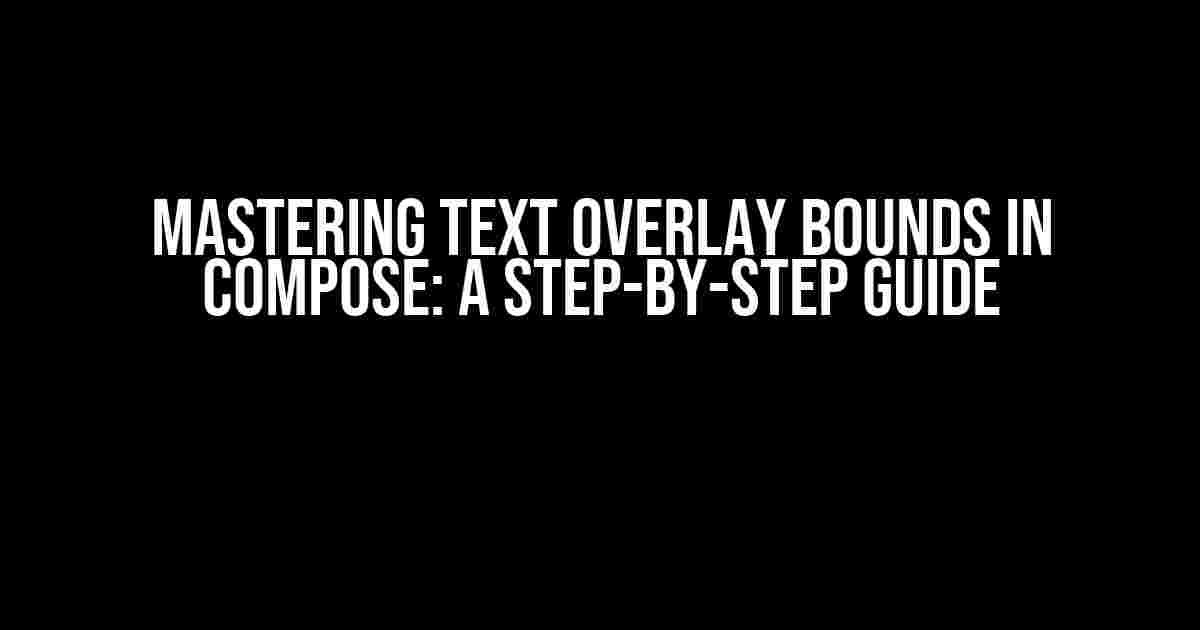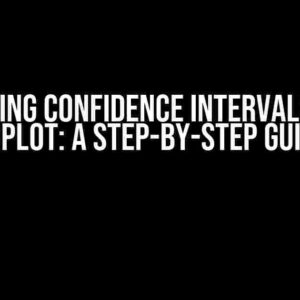Are you tired of dealing with unruly text overlays that refuse to stay within the confines of your video? Do you struggle to split your text into multiple lines automatically? Fear not, dear reader, for we’re about to dive into the wonderful world of text overlay bounds in Compose!
Understanding the Problem: Why Text Overlays Go Rogue
Before we dive into the solution, let’s first understand why text overlays often go haywire. When you add text to your video in Compose, it’s easy to get carried away with the excitement of adding captions, subtitles, or credits. However, without proper bounds, your text can easily spill over the edges of your video, creating an unsightly mess.
The Consequences of Unbound Text
- Visual Clutter: Unbound text can create visual clutter, making it difficult for viewers to focus on the main content.
- Legibility Issues: When text overflows, it can become illegible, defeating the purpose of adding it in the first place.
- Aesthetics: Unbound text can ruin the overall aesthetic of your video, making it look amateurish and unprofessional.
Setting Text Overlay Bounds: A Step-by-Step Guide
Fortunately, Compose provides an easy way to set text overlay bounds, ensuring your text stays within the confines of your video. Follow these simple steps:
Step 1: Select the Text Layer
In your Compose project, select the text layer you want to adjust. You can do this by clicking on the layer in the timeline or by using the layer panel.
Timeline:
+-- Text Layer
+-- Audio Layer
+-- Video Layer
Layer Panel:
+-- Text Layer 1
+-- Text Layer 2
+-- ...
Step 2: Access the Text Properties Panel
With the text layer selected, access the text properties panel by clicking on the ” Properties” icon in the top toolbar or by using the shortcut key (Ctrl + Shift + P on Windows or Cmd + Shift + P on Mac).
Properties Panel:
+-- Text
+-- Font
+-- Size
+-- Color
+-- ...
Step 3: Enable Text Bounding
In the text properties panel, scroll down to the “Bounding” section and enable “Text Bounding” by toggling the switch.
Bounding:
+-- Text Bounding:
+-- Horizontal Align:
+-- Vertical Align:
Step 4: Set the Bounds
With text bounding enabled, you can set the bounds by adjusting the “Width” and “Height” values. You can enter a specific value in pixels or use the built-in presets.
Bounding:
+-- Text Bounding:
+-- Width: 800px
+-- Height: 600px
Automatic Line Breaks: A Game-Changer for Text Overlays
One of the most significant benefits of setting text overlay bounds is the ability to automatically split your text into multiple lines. This feature is a game-changer for creating clean, readable text overlays.
How Automatic Line Breaks Work
When you enable text bounding, Compose analyzes the text content and automatically breaks it into multiple lines based on the set bounds. This ensures that your text never overflows the boundaries of your video.
Customizing Line Breaks: Advanced Options
While automatic line breaks are convenient, you may want to customize the behavior to suit your specific needs. Compose provides advanced options to fine-tune line breaks:
| Option | Description |
|---|---|
| Line Break Mode | Determines how Compose breaks lines: Word Wrap, Character Wrap, or Manual. |
| Line Height | Controls the spacing between lines: pixels, percentage, or fixed. |
| Line Alignment | Aligns text to left, center, right, or justified. |
Best Practices for Text Overlay Bounds in Compose
To get the most out of text overlay bounds, follow these best practices:
- Use Consistent Bounds: Establish a consistent bounding scheme throughout your project to maintain visual coherence.
- Adjust Bounds Dynamically: Use Compose’s dynamic bounding features to adapt to changing video resolutions or aspect ratios.
- Test and Refine: Preview your text overlays and refine the bounds as needed to ensure optimal legibility and aesthetics.
- Keep it Simple: Avoid overusing text overlays or using excessive bounding options, as this can lead to visual clutter.
Conclusion: Mastering Text Overlay Bounds in Compose
By following this comprehensive guide, you’ve learned how to set text overlay bounds in Compose, ensuring your text stays within the confines of your video and splits into multiple lines automatically. With these newfound skills, you’ll be able to create clean, professional-looking videos that engage your audience.
Remember, mastering text overlay bounds is just one aspect of creating stunning videos. Experiment with Compose’s vast range of features, and you’ll be well on your way to becoming a video production maestro!
Frequently Asked Question
Get the answers to your text overlay woes and learn how to keep your text in check!
Can I set text overlay bounds to prevent it from going out of the video frame?
Yes, you can! In Compose, you can set a boundary for your text overlay by using the “Bounds” property. This will ensure that your text doesn’t exceed the video frame and stays neatly within its confines.
Is it possible to split the text into multiple lines automatically?
Absolutely! Compose allows you to enable text wrapping, which will automatically split your text into multiple lines when it reaches the boundary of the frame. This feature ensures that your text remains readable and visually appealing.
How do I access the “Bounds” property in Compose?
To access the “Bounds” property, simply select the text overlay layer in your Compose project, then navigate to the “Properties” panel and look for the “Bounds” section. From there, you can adjust the settings to set the desired boundaries for your text overlay.
Can I customize the text wrapping behavior in Compose?
Yes, you can! Compose offers various text wrapping options, such as wrap to width, wrap to height, or wrap to both. You can also customize the wrap mode, alignment, and even the spacing between lines to achieve the desired look.
Will setting text overlay bounds affect the overall video resolution?
No, setting text overlay bounds in Compose will not affect the overall video resolution. The bounds property only affects the text layer, ensuring that it stays within the designated area without impacting the underlying video.


